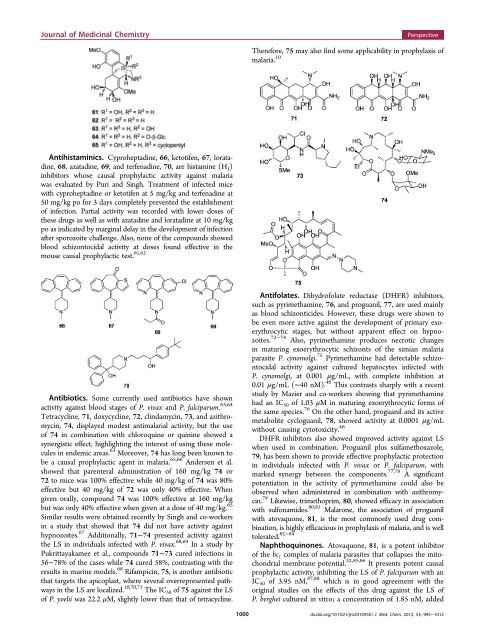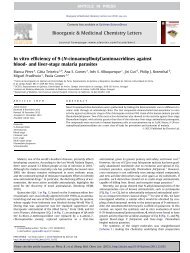Targeting the Liver Stage of Malaria Parasites - American Chemical ...
Targeting the Liver Stage of Malaria Parasites - American Chemical ...
Targeting the Liver Stage of Malaria Parasites - American Chemical ...
Create successful ePaper yourself
Turn your PDF publications into a flip-book with our unique Google optimized e-Paper software.
Journal <strong>of</strong> Medicinal ChemistryPerspectiveTherefore, 75 may also find some applicability in prophylaxis <strong>of</strong>malaria. 10Antihistaminics. Cyproheptadine, 66, ketotifen, 67, loratadine,68, azatadine,69, and terfenadine, 70, are histamine (H 1 )inhibitors whose causal prophylactic activity against malariawas evaluated by Puri and Singh. Treatment <strong>of</strong> infected micewith cyproheptadine or ketotifen at 5 mg/kg and terfenadine at50 mg/kg po for 3 days completely prevented <strong>the</strong> establishment<strong>of</strong> infection. Partial activity was recorded with lower doses <strong>of</strong><strong>the</strong>se drugs as well as with azatadine and loratadine at 10 mg/kgpo as indicated by marginal delay in <strong>the</strong> development <strong>of</strong> infectionafter sporozoite challenge. Also, none <strong>of</strong> <strong>the</strong> compounds showedblood schizontocidal activity at doses found effective in <strong>the</strong>mouse causal prophylactic test. 61,62Antibiotics. Some currently used antibiotics have shownactivity against blood stages <strong>of</strong> P. vivax and P. falciparum. 63,64Tetracycline, 71, doxycycline, 72, clindamycin, 73, and azithromycin,74, displayed modest antimalarial activity, but <strong>the</strong> use<strong>of</strong> 74 in combination with chloroquine or quinine showed asynergistic effect, highlighting <strong>the</strong> interest <strong>of</strong> using <strong>the</strong>se moleculesin endemic areas. 63 Moreover, 74 has long been known tobe a causal prophylactic agent in malaria. 65,66 Andersen et al.showed that parenteral administration <strong>of</strong> 160 mg/kg 74 or72 to mice was 100% effective while 40 mg/kg <strong>of</strong> 74 was 80%effective but 40 mg/kg <strong>of</strong> 72 was only 40% effective. Whengiven orally, compound 74 was 100% effective at 160 mg/kgbut was only 40% effective when given at a dose <strong>of</strong> 40 mg/kg. 65Similar results were obtained recently by Singh and co-workersin a study that showed that 74 did not have activity againsthypnozoites. 67 Additionally, 71−74 presented activity against<strong>the</strong> LS in individuals infected with P. vivax. 68,69 In a study byPukrittayakamee et al., compounds 71−73 cured infections in56−78% <strong>of</strong> <strong>the</strong> cases while 74 cured 58%, contrasting with <strong>the</strong>results in murine models. 68 Rifampicin, 75, is ano<strong>the</strong>r antibioticthat targets <strong>the</strong> apicoplast, where several overrepresented pathwaysin <strong>the</strong> LS are localized. 10,70,71 The IC 50 <strong>of</strong> 75 against <strong>the</strong> LS<strong>of</strong> P. yoelii was 22.2 μM, slightly lower than that <strong>of</strong> tetracycline.1000Antifolates. Dihydr<strong>of</strong>olate reductase (DHFR) inhibitors,such as pyrimethamine, 76, and proguanil, 77, are used mainlyas blood schizonticides. However, <strong>the</strong>se drugs were shown tobe even more active against <strong>the</strong> development <strong>of</strong> primary exoerythrocyticstages, but without apparent effect on hypnozoites.72−74 Also, pyrimethamine produces necrotic changesin maturing exoerythrocytic schizonts <strong>of</strong> <strong>the</strong> simian malariaparasite P. cynomolgi. 75 Pyrimethamine had detectable schizontocidalactivity against cultured hepatocytes infected withP. cynomolgi, at 0.001 μg/mL, with complete inhibition at0.01 μg/mL (∼40 nM). 46 This contrasts sharply with a recentstudy by Mazier and co-workers showing that pyrimethaminehad an IC 50 <strong>of</strong> 1.03 μM in maturing exoerythrocytic forms <strong>of</strong><strong>the</strong> same species. 76 On <strong>the</strong> o<strong>the</strong>r hand, proguanil and its activemetabolite cycloguanil, 78, showed activity at 0.0001 μg/mLwithout causing cytotoxicity. 46DHFR inhibitors also showed improved activity against LSwhen used in combination. Proguanil plus sulfamethoxazole,79, has been shown to provide effective prophylactic protectionin individuals infected with P. vivax or P. falciparum, withmarked synergy between <strong>the</strong> components. 77,78 A significantpotentiation in <strong>the</strong> activity <strong>of</strong> pyrimethamine could also beobserved when administered in combination with azithromycin.79 Likewise, trimethoprim, 80, showed efficacy in associationwith sulfonamides. 80,81 Malarone, <strong>the</strong> association <strong>of</strong> proguanilwith atovaquone, 81, is <strong>the</strong> most commonly used drug combination,is highly efficacious in prophylaxis <strong>of</strong> malaria, and is welltolerated. 82−84Naphthoquinones. Atovaquone, 81, is a potent inhibitor<strong>of</strong> <strong>the</strong> bc 1 complex <strong>of</strong> malaria parasites that collapses <strong>the</strong> mitochondrialmembrane potential. 32,85,86 It presents potent causalprophylactic activity, inhibiting <strong>the</strong> LS <strong>of</strong> P. falciparum with anIC 50 <strong>of</strong> 3.95 nM, 87,88 which is in good agreement with <strong>the</strong>original studies on <strong>the</strong> effects <strong>of</strong> this drug against <strong>the</strong> LS <strong>of</strong>P. berghei cultured in vitro; a concentration <strong>of</strong> 1.85 nM, addeddx.doi.org/10.1021/jm201095h | J. Med. Chem. 2012, 55, 995−1012



